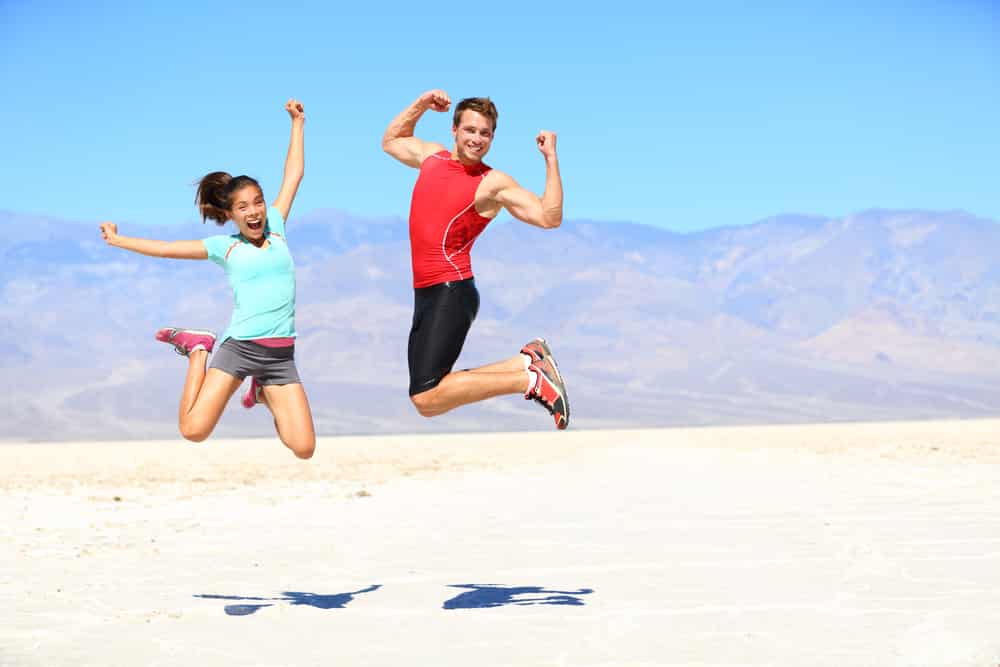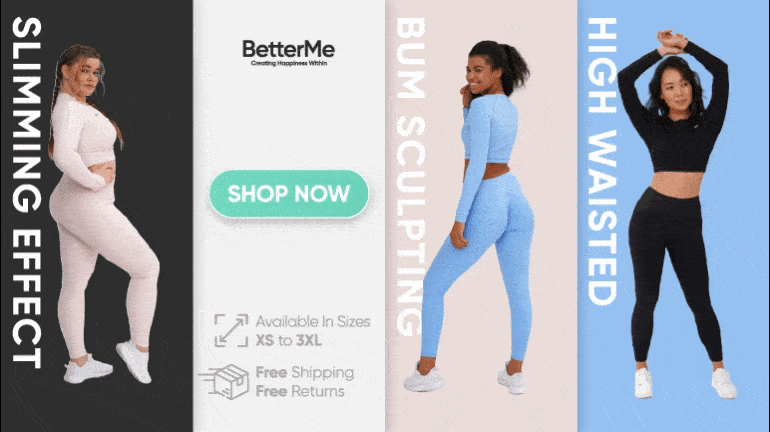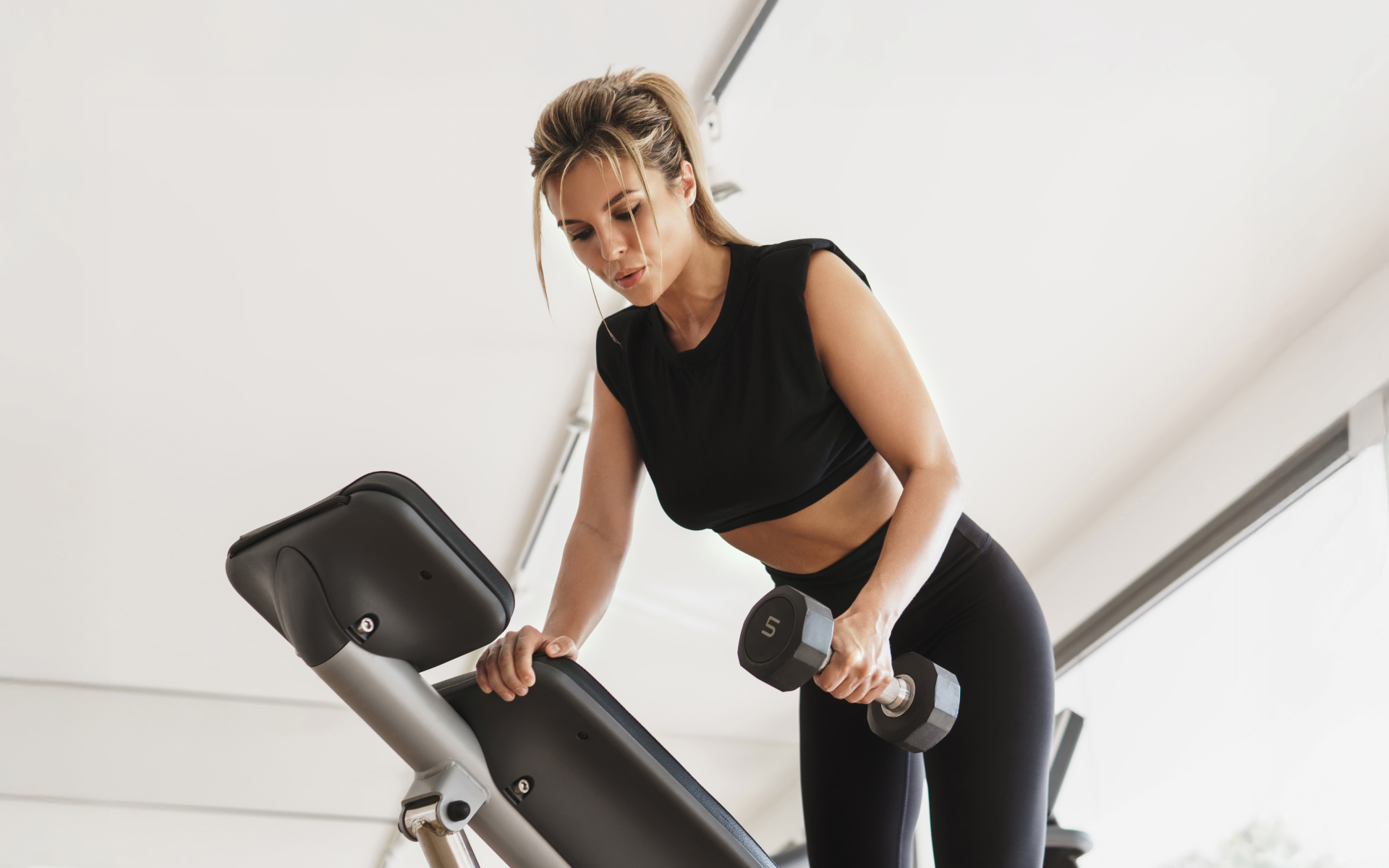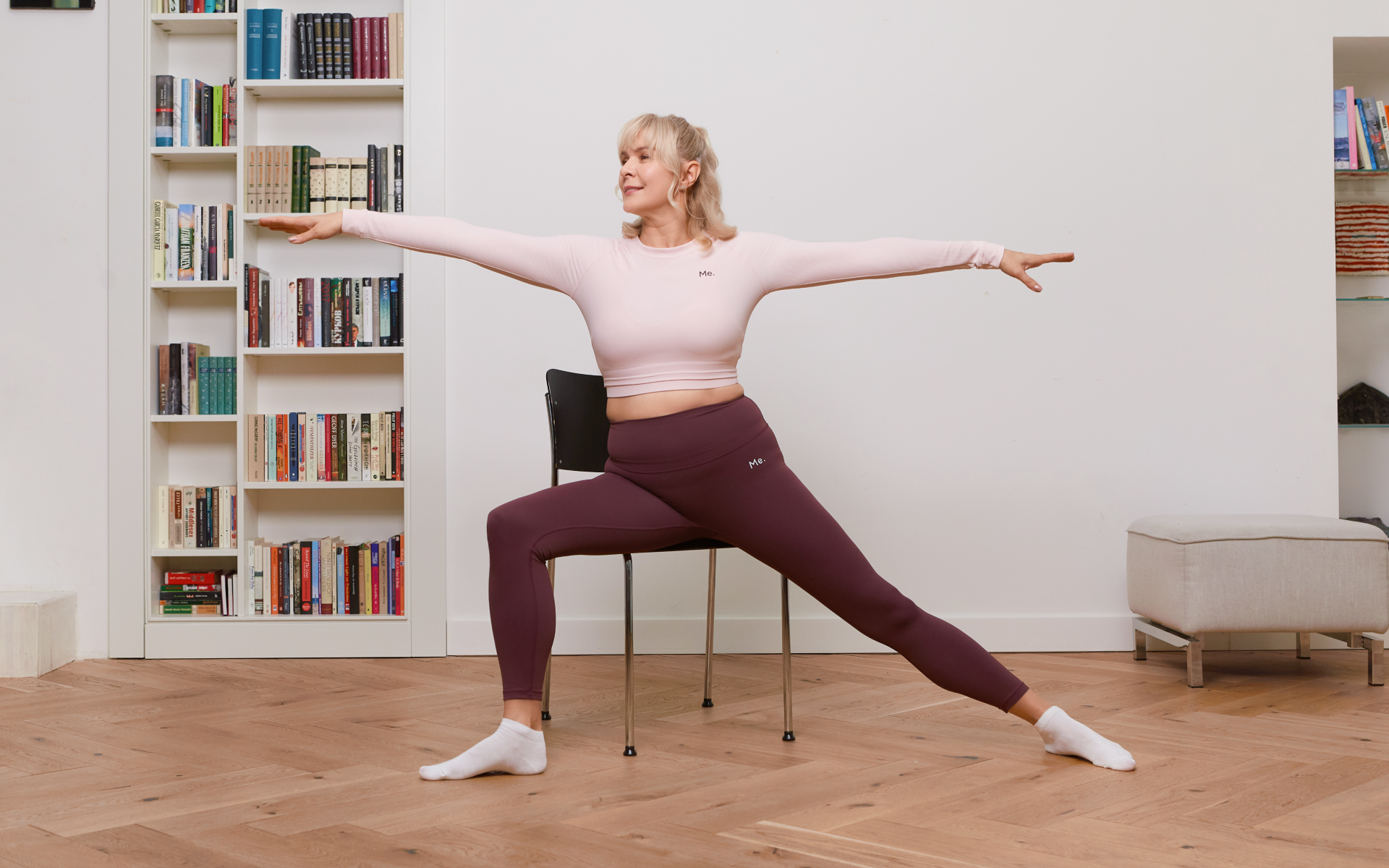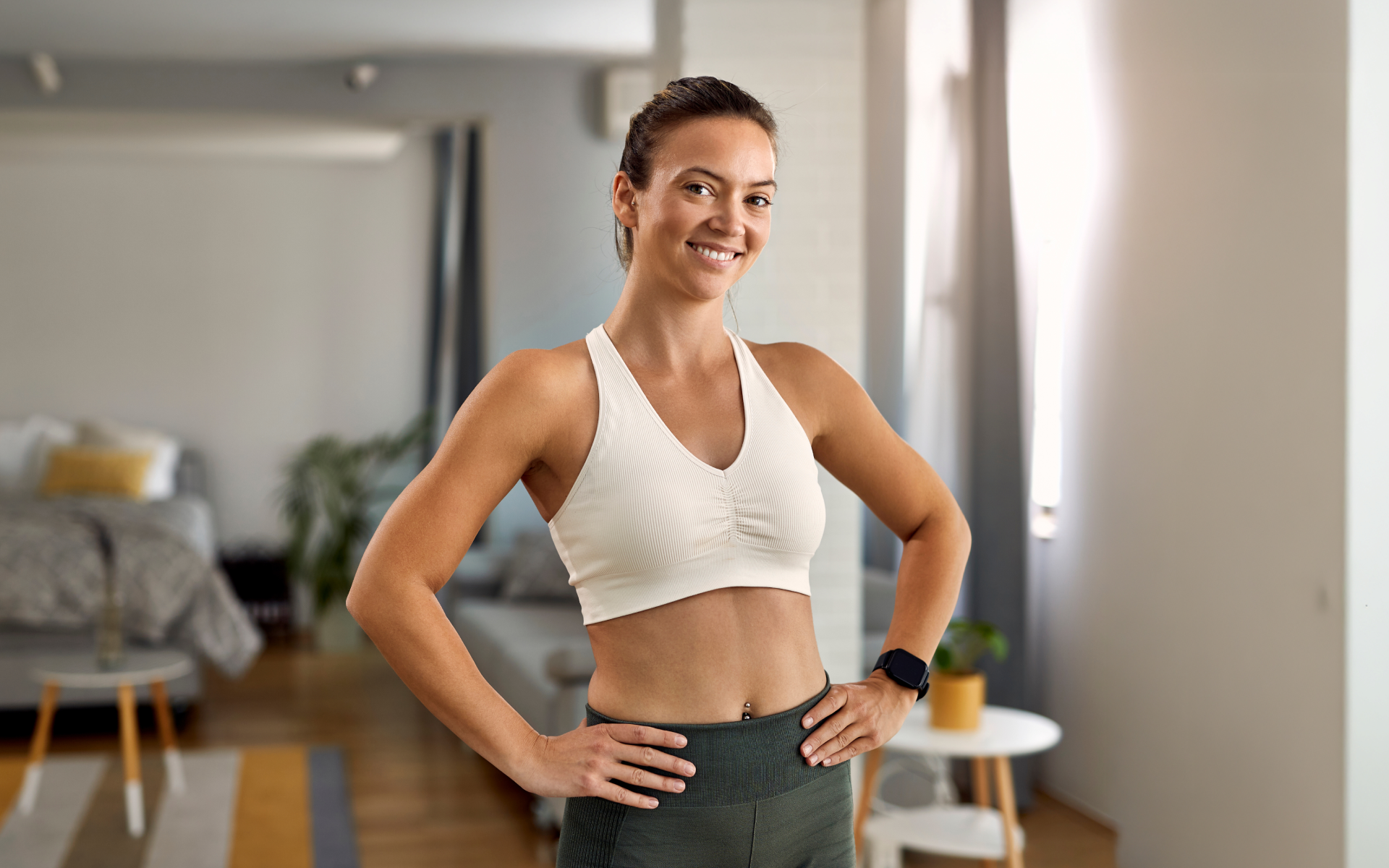Everyone beginning a weight loss journey has some motivations that keep them in check. Maybe you want to lose some belly fat so you can fit into that bodycon dress you bought last summer, or maybe you want to shed a few extra pounds for the sake of your overall health and wellbeing. Whatever your reasons for wanting to lose weight are, one thing is clear – you want to see results. And while the need to see your body change may send you into overdrive, it is also a great motivator. If you are just beginning your fitness journey, one of the questions you have undoubtedly asked yourself is “Where do you lose weight first?” or “Where do you lose weight first on Keto diet?” The answer may (or may not) be what you want to hear.
Get your personalized
meal plan!

Where Do You Lose Weight First On Your Body?
The fact is that everyone carries fat in different parts of their body (read, we all carry fat differently). One person may carry most of their body fat around their midsection, while someone else carries their fat on the hips, etc. This is mostly dependent on genes (44, 46).
In the same vein, where you lose weight first depends on your genes. Ergo, you have no control as to where you lose weight. This realization may frustrate you, and you are not alone.
Studies have shown that genetics can actually account for about sixty percent of the fat distribution in your body.
Further studies have even identified genes associated with fat accumulation in the body. One such gene is the FTO gene (previously known as the Fatso gene) (24, 45).
But, you need not give up yet. Although you have no control as to where you lose body fat first, some general trends have been observed in the past that may give you an idea of what to expect.
- One, you may lose weight where you normally gain it the fastest. For example, if you normally tend to gain weight around the midsection easily, then this might be the first place that you will actually lose weight as well.
- Or you may lose weight wherever you last gained it. If arm fat is the last weight that you gained, then you will lose arm fat first.
Another thing to note is that weight loss does not occur haphazardly. In fact, as you lose weight, you will also slim down in a way that is actually proportional for your body type. For example, if you have an apple-shaped body, then you will keep that general build as you slim down, only that your body size will reduce.
Spot Reduction
Many a time, you will find someone saying that they need to lose belly fat alone, or they just need to fix their glutes – but this is actually impossible, as you cannot target only one part of your body while working out. Enter – spot reduction.
Spot reduction refers to the localized loss of subcutaneous fat as a result of exercising that particular part of the body (39). In reality, spot reduction is impossible.
In fact, studies have shown that you cannot spot reduce fat in specific parts of your body, no matter how hard you try. This is especially true in the abdomen (19, 43).
A 2013 study published in the Journal of Strength and Conditioning Research had participants train their leg muscles with leg presses regularly and repetitively for twelve weeks (33). Despite the targeted exercise, they only lost fat in the upper body, not in the exercised legs.
Another study took a look at young tennis players to see if there was a significant difference in fat mass between both of their arms (25). One would expect that the dominant hand should have less fat, right?
However, the scientists conducting the study found that playing tennis was associated with lower abdominal fat, but there was no difference in the fat mass between either arm.
Not only is spot-training meaningless, but it may also derail your overall weight loss journey. While spot-training, you neglect strengthening the entire body and limit the amount of lean muscle mass created in your body.
Lean muscle mass is important because it boosts your overall metabolism and leads to a healthier overall appearance.
Rather than spot-training, follow a workout routine that strengthens your entire body.
Anyone on a fitness journey needs to remember that long-term weight loss is dependent on a healthy diet and exercise, and no one workout routine will help you lose just belly fat, or help you just tone your butt alone.
By following a regular exercise routine and eating healthy, you will see a difference in your overall body weight after some time.
Is There A Difference In Fat Loss For Men And Women?
While people do not lose weight the same way, there are some general differences in fat loss for men and women. Men and women actually lose weight differently depending on the types of fat they contain and childbearing factors (thanks Mother Nature).
Previous research shows that women have more subcutaneous fat, a type of fat whose deposits sit right underneath the skin and is partially responsible for ladies’ curves (38, 49).
Men, on the other hand, tend to carry more abdominal and visceral fat. Visceral fat is the fat that you have on the inside of your body, the kind of fat surrounding your organs.
Let’s delve deeper into the differences in fat loss for women and men.
Read More: 30 Day Fast Weight Loss: Can You Fast Your Way To Fat Loss?
Where Do You Lose Weight First: Guys
Where do you lose weight first: men? Well, as stated earlier, men tend to carry more abdominal and visceral fat than subcutaneous fat.
Despite the abdominal area being a common location for weight gain, men tend to lose weight in the legs first, followed by the arms and back.
If you struggle to even flirt with the idea of giving up your favorite foods or working out till your legs give way – BetterMe app is here to breathe a fresh perspective into the way you view the weight loss process! Check out the app and experience the fun side of fitness and dieting with BetterMe!
Where Do You Lose Weight First: Girls
Where do you lose weight first: women? For women, it is a bit different.
Generally, women tend to lose weight all over but hold onto the weight in their thighs and hips. These areas also contain more fat cells, with each cell larger than those in many other regions of the body.
Fat accumulates in these areas during a lady’s teenage years as hormone levels fluctuate, and by the age of 25, women of healthy weight have about twice the total body fat of men.
But why?A woman’s body is wired in such a way that it always has to be ready to get pregnant. Therefore, it is common that many women following a weight loss regimen witness weight loss on their backs, faces, and even calves while the fat around their hips, butts, and thighs remains put for the first several weeks.
The fat on these body parts is important for childbearing and is related to the higher levels of estrogen necessarily for fertility.
So, ladies, you may need to stop looking for ways on how to lose weight in your thighs – follow your regular routine, and let Mother Nature have a ball.
As women near menopause, their estrogen levels drop, and this is why menopausal women may witness weight gain shift to the belly (20).
Where Do You Lose Weight First When Walking?
For effective weight loss, Mayo Clinic suggests a combination of physical activity and healthy dietary choices that include eating fewer calories (6). This approach is more feasible and effective as opposed to a healthy diet alone or exercising alone.
Physical activity like walking is important for weight loss and weight management as it helps you burn calories (11).
Adding 30 minutes of brisk walking to your daily routine may help you burn about 150 more calories a day.
A study in the Journal of Exercise Nutrition and Biochemistry revealed the positive effects that walking could have on burning fat and reducing waist circumference in obese females (16) .
The women in the study walked between 50 to 70 minutes 3 days per week for a total of twelve weeks. After the study, the scientists found that the study participants lost an average of 1.5% body fat and 1.1 inches around their waists.
While no one can tell where they will lose weight first while walking (or doing any physical activity for that matter), there are some things that you could do to increase the amount of fat you burn while walking.
They include:
-
Picking Up The Pace
Pace makes a huge difference when it comes to walking for weight loss. You will definitely burn more calories while walking at a brisk pace as opposed to walking more slowly (3).
One study published in Medicine & Science in Sports and Exercise showed that when people increased their walking pace to a run, they burned more calories (26).
The study also revealed that the group of runners weighed less overall than the walkers, suggesting that speed directly affects the number of calories a person burns while exercising.
But, increasing the pace does not mean a person has to run, really. Instead, walk briskly to burn those extra calories and boost your weight loss.
-
Focusing On Your Form And Posture While You Walk
As it is when doing any other type of exercise, form and posture matters, a lot. Even though you have been walking since you were a child, you might not be doing it right – at least for the sake of initiating weight loss.
To get the most out of walking, walk in such a way that you are looking ahead at all times. This helps to increase the speed that you can walk as well as lengthen your stride.
While walking, also focus on tightening your abdominal muscles and glutes. You can either do this during the entire length of the walk or for short intervals.
-
Wearing A Weighted Vest
It is a no-brainer that adding extra weights to a work out will help you burn more calories. In the same way, heavier people tend to burn more calories as their bodies need more energy to perform the same task than someone who is not as heavy.
Wearing a weighted vest while walking will encourage your body to work harder during a walk.
A study concluded that individuals who walked at 2.5 miles per hour on a flat surface while wearing a weighted vest that weighed 15% of their weight burned 12% more calories than those who did not wear a vest (47).
In the same study, a person wearing a weighted vest that represented 10% of their body weight and who walked at the same pace on a 5-10% gradient burned an average of 13% more calories.
While a weighted vest may help burn more calories, you should avoid wearing ankle or wrist weights or even carrying weights in your hands while walking, as this can lead to muscle imbalance and injury.
Read More: A 21-Day Walking Plan For Fat Loss
-
Adding Resistance Training Intervals While Walking
You could try adding resistance training during your walk (4, 33). This will not only help you burn more calories, but will also increase the growth of new muscle.
These short exercise intervals can help increase your heart rate as well, and they will definitely make your walking routine more interesting.
Some exercises you could add include squats, lunges, burpees, pushups, or tricep dips.
-
Walking Uphill
Challenge yourself by walking uphill regularly to increase calorie burn. If you are walking outside, you could add climbing hills into your walking routine. For those using a treadmill, increase the treadmill gradient.
Generally, aim to walk up hills, stairs or inclines 2 to 3 times a week.
-
Power Walking In Intervals
To try power walking in intervals, first walk for about 5 to 10 minutes to warm up. Gradually increase the pace and continue at an uncomfortable but sustainable pace for 10 to 15 seconds before returning to a normal walking pace.
Repeat this throughout the walk or for as long as you can manage it.
Where Do You Lose Weight First When Starving?
First of all, starving is heavily frowned upon. Starvation diets have more negative effects on the body than positive (7, 9).
Starving yourself changes your body’s metabolism, reduces lean muscle, reduces bone density, and decreases your overall strength (32).
For healthier and more sustainable weight loss, follow a healthier approach to losing weight that involves eating healthy meals and increasing physical activity – all in order to create a calorie deficit.
One research indicated that people who used starvation diets for weight loss, eating 50% of their energy needs for three weeks, decreased their body weight overall. However, the same people also reduced their lean muscle mass by 5% (9).
The study further concluded that if a state of starvation is maintained chronically, lean muscle mass and organ size are decreased by a whopping 20%.
Another study, on rats this time, revealed that lean mass and lean muscle mass were lost during starvation (41). However, body fat stores were relatively the same in mice on a control diet and obese mice on starvation diets.
Weight loss through starvation may make you lose a significant amount of lean muscle mass and lean body mass, which encompasses water, bones, and organs.
Reducing the mass of your bones decreases bone density, which can make you more prone to injury. Increasing lean body mass, on the other hand, increases bone strength and density.
One study using human participants revealed that dropping significant amounts of calories from the diet led to significant weight loss and decreased lean muscle mass. However, the participants also gained back nearly all of the fat they lost within 8 years (7).
This is enough proof that you should definitely not starve yourself!
Losing Face Fat 101: A Guide We All Need
One of the very first places you may want to lose fat is on your face. If you are not a fan of having a chubby face, then there are some things that you can do to keep facial fat in check.
Note that these tips aren’t geared towards spot reduction. In fact, they are general tips that will improve your general fat loss, facial fat included (8).
-
Facial Exercises
Facial exercises such as puffing out your cheeks and pushing the air from side to side, puckering your lips on alternating sides, and holding a smile while clenching your teeth for several seconds at a time can be used to improve your facial appearance, combat ageing, and improve muscle strength.
Some reports claim that adding facial exercises to your routine can also tone facial muscles, making your face appear slimmer (42). Although evidence of this is limited, one study reported that facial exercises might build muscle tone in your face.
Another study revealed that performing facial muscle exercises twice per day for eight weeks increased muscle thickness and contributed to facial rejuvenation (12).
-
Avoid Refined Carbs
Refined carbs are carbs that have been heavily processed, stripping them of their beneficial nutrients and fiber, leaving little behind besides sugar and calories.
Because refined carbs contain very little fibre, they are digested rapidly, leading to spikes and crashes in blood sugar levels and a higher risk of overeating.
One study in 277 women revealed that a higher intake of refined carbs was associated with a higher risk of obesity and a greater amount of belly fat (2).
Try swapping out refined carbs for whole grains to increase overall weight loss, which may also aid in facial fat loss (23, 48).
-
Consume Less Sodium
Excess sodium intake causes bloating, which in turn contributes to facial swelling and puffiness. This is because sodium causes your body to retain extra water.
Studies have shown that high sodium intake can increase fluid retention, especially in people who are more sensitive to the effects of salt (30, 35, 36).
-
Drink More Water
Numerous studies have asserted that drinking water keeps you feeling full and enhances weight loss (17).
One such study found that drinking water before a meal significantly decreased the number of calories consumed during the meal (14).
Other studies show that drinking water may temporarily increase your metabolism, and therefore increase the number of calories you burn over the course of the day. This helps in weight loss.
According to a 2016 review of the relationship between hydration and weight loss, water consumption also promotes lipolysis (29). Lipolysis occurs when the body breaks down fat stores into fatty acids that it can use as energy. Making use of these fat stores is key to losing weight.
Whether you’re a workout beast or just a beginner making your first foray into the world of fitness and dieting – BetterMe has a lot to offer to both newbies and experts! Install the app and experience the versatility first-hand!
-
Do Cardio
More often than not, the extra fat in your face is the result of excess body fat in general. As such, losing the excess body fat may ultimately lead to loss of facial fat.
Cardio increases your heart rate and can help to promote fat burning and increase fat loss.
A 2012 study investigated the effects of different types of exercise on fat mass in people with obesity (18). In the study, 119 adults took part in one of the following three 8-month exercise programs:
- Aerobics training (AT)
- Resistance training (RT)
- A combination of AT and RT
Both the AT group and the combination group showed greater reductions in fat mass compared with the RT group. However, there was no significant difference in outcomes between these two groups. The RT and combination groups increased muscle mass more than the AT-only group, as you might expect.
The study authors, therefore, concluded that people mainly looking to burn fat should opt for AT exercises over RT exercises.
For results, try getting about 150 to 300 minutes of moderate to vigorous exercise each week, which is equivalent to approximately 20 to 40 minutes of cardio per day.
Some examples of cardio exercise include dancing, walking, cycling, running, and swimming.
-
Eat More Fibre-Rich Foods
Consuming fiber-rich foods keeps you feeling fuller for longer, curbs cravings, and decreases appetite (5, 27, 50).
Fibre intake is associated with increased weight loss and improved adherence to a low-calorie diet.
A review of several studies showed that consuming more soluble fibre may reduce both body weight and waist circumference, even without restricting calories (22). Soluble fiber refers to a type of fiber that forms a gel when mixed with water.
Fiber is naturally found in fruits, vegetables, nuts, seeds, whole grains, and legumes. It would be best if you aimed to consume at least 25 to 38 grams of fiber per day.
-
Skip The Cocktail – Avoid Alcohol
Excessive alcohol consumption promotes facial fat accumulation and bloating as well (1). Furthermore, alcohol is high in calories, low in nutrients and is associated with an increased risk of weight gain.
You may not want to stop drinking alcohol altogether, so just drink in moderation.
According to the current U.S. Dietary Guidelines for Americans, moderate drinking is defined as up to 2 drinks per day for men and up to 1 drink per day for women (10).
-
Improve The Quality Of Your Sleep
Lack of sleep can cause an increase in levels of cortisol, a stress hormone that fuels weight gain.
Studies have shown that high cortisol levels can increase your appetite and alter your metabolism, resulting in increased fat storage (37).
One study even found that better sleep quality was associated with successful weight loss maintenance (15).
Other studies have shown that sleep deprivation can increase food intake, cause weight gain, and lower a person’s metabolism (21, 28, 31, 34, 40).
Ideally, aim for at least 8 hours of sleep per night to aid weight control and facial fat loss.
Conclusion
Unfortunately, no one can accurately answer the question “Where do you lose weight first?”. It is all dependent on your genes, so you have your parents to thank for that. However, by sticking to a regular workout routine, making healthy dietary choices, and maintaining a calorie deficit, you will lose overall body fat and notice changes in your body – including the places that you really want to ‘fix’.
DISCLAIMER:
This article is intended for general informational purposes only and does not address individual circumstances. It is not a substitute for professional advice or help and should not be relied on to make decisions of any kind. Any action you take upon the information presented in this article is strictly at your own risk and responsibility!
SOURCES:
- Alcohol Consumption and Obesity: An Update (2015, ncbi.nlm.nih.gov)
- Association between Carbohydrate Quality Index and general and abdominal obesity in women: a cross-sectional study from Ghana (2019, ncbi.nlm.nih.gov)
- Benefits of different intensity of aerobic exercise in modulating body composition among obese young adults: a pilot randomized controlled trial (2017, ncbi.nlm.nih.gov)
- Caloric expenditure of aerobic, resistance, or combined high-intensity interval training using a hydraulic resistance system in healthy men (2015, pubmed.ncbi.nlm.nih.gov)
- Can dietary viscous fiber affect body weight independently of an energy-restrictive diet? A systematic review and meta-analysis of randomized controlled trials (2020, pubmed.ncbi.nlm.nih.gov)
- Can I lose weight if my only exercise is walking? (2018, mayoclinic.org)
- Changes in body composition produced by prolonged total starvation and refeeding (1969, metabolismjournal.com)
- Changes in body composition over 8 years in a randomized trial of a lifestyle intervention: The look AHEAD study (2015, onlinelibrary.wiley.com)
- Chronic starvation secondary to anorexia nervosa is associated with an adaptive suppression of resting energy expenditure (2014, pubmed.ncbi.nlm.nih.gov)
- Dietary Guidelines for Alcohol (2019, cdc.gov)
- Dose-response effect of walking exercise on weight loss. How much is enough? (2002, pubmed.ncbi.nlm.nih.gov)
- Effect of a Facial Muscle Exercise Device on Facial Rejuvenation (2018, pubmed.ncbi.nlm.nih.gov)
- Effect of Pre-Exhaustion Exercise on Lower-Extremity Muscle Activation During a Leg Press Exercise (2003, researchgate.net)
- Effect of Pre-meal Water Consumption on Energy Intake and Satiety in Non-obese Young Adults (2018, ncbi.nlm.nih.gov)
- Effect of shortened sleep on energy expenditure, core body temperature, and appetite: a human randomised crossover trial (2017, ncbi.nlm.nih.gov)
- Effect of walking exercise on abdominal fat, insulin resistance and serum cytokines in obese women (2014, pubmed.ncbi.nlm.nih.gov)
- Effect of ‘Water Induced Thermogenesis’ on Body Weight, Body Mass Index and Body Composition of Overweight Subjects (2013, ncbi.nlm.nih.gov)
- Effects of aerobic and/or resistance training on body mass and fat mass in overweight or obese adults (2012, ncbi.nlm.nih.gov)
- Effects of aerobic and resistance training on abdominal fat, apolipoproteins and high-sensitivity C-reactive protein in adolescents with obesity: the HEARTY randomized clinical trial (2015, pubmed.ncbi.nlm.nih.gov)
- Effects of a High vs Moderate Volume of Aerobic Exercise on Adiposity Outcomes in Postmenopausal Women: A Randomized Clinical Trial (2015, pubmed.ncbi.nlm.nih.gov)
- Effects of sleep deprivation on serum cortisol level and mental health in servicemen (2015, pubmed.ncbi.nlm.nih.gov)
- Fiber Intake Predicts Weight Loss and Dietary Adherence in Adults Consuming Calorie-Restricted Diets: The POUNDS Lost (Preventing Overweight Using Novel Dietary Strategies) Study (2019, pubmed.ncbi.nlm.nih.gov)
- Food Addiction, High Glycemic Index Carbohydrates and Obesity (2017, ncbi.nlm.nih.gov/pmc)
- FTO Gene Associated Fatness in Relation to Body Fat Distribution and Metabolic Traits throughout a Broad Range of Fatness (2008, ncbi.nlm.nih.gov)
- Greater Reduction in Abdominal Than in Upper Arms Subcutaneous Fat in 10- to 12-Year-Old Tennis Players: A Volumetric MRI Study (2019, ncbi.nlm.nih.gov)
- Greater Weight Loss from Running than Walking during a 6.2-yr Prospective Follow-up (2013, journals.lww.com)
- High Fiber Diet (2020, ncbi.nlm.nih.gov)
- Impact of insufficient sleep on total daily energy expenditure, food intake, and weight gain (2013, ncbi.nlm.nih.gov)
- Increased Hydration Can Be Associated with Weight Loss (2016, ncbi.nlm.nih.gov)
- Increased salt consumption induces body water conservation and decreases fluid intake (2017, ncbi.nlm.nih.gov)
- Interactions between sleep, stress, and metabolism: From physiological to pathological conditions (2015, ncbi.nlm.nih.gov)
- Metabolic adaptation to caloric restriction and subsequent refeeding: the Minnesota Starvation Experiment revisited (2015, pubmed.ncbi.nlm.nih.gov)
- Regional fat changes induced by localized muscle endurance resistance training (2013, pubmed.ncbi.nlm.nih.gov)
- Resting metabolic rate varies by race and by sleep duration (2015, ncbi.nlm.nih.gov)
- Salt and water: not so simple (2017, pubmed.ncbi.nlm.nih.gov)
- Sodium (2014, ncbi.nlm.nih.gov)
- Stress, cortisol, and other appetite-related hormones: Prospective prediction of 6-month changes in food cravings and weight (2018, ncbi.nlm.nih.gov)
- Subcutaneous and visceral adipose tissue: structural and functional differences (2010, pubmed.ncbi.nlm.nih.gov)
- Subcutaneous Fat Alterations Resulting from an Upper-Body Resistance Training Program (2007, journals.lww.com)
- Successful weight loss maintenance associated with morning chronotype and better sleep quality (2015, ncbi.nlm.nih.gov)
- Survival and body composition of normal and hypothalamic obese rats in acute starvation (1960, journals.physiology.org)
- The effectiveness of facial exercises for facial rejuvenation: a systematic review (2014, pubmed.ncbi.nlm.nih.gov)
- The effect of abdominal exercise on abdominal fat (2011, pubmed.ncbi.nlm.nih.gov)
- The genetics of fat distribution (2014, pubmed.ncbi.nlm.nih.gov)
- The genetics of obesity: FTO leads the way (2010, pubmed.ncbi.nlm.nih.gov)
- The genetic underpinnings of body fat distribution (2017, pubmed.ncbi.nlm.nih.gov)
- The Metabolic Cost of Slow Graded Treadmill Walking With a Weighted Vest in Untrained Females (2013, acewebcontent.azureedge.net)
- The Relationship between Whole Grain Intake and Body Weight: Results of Meta-Analyses of Observational Studies and Randomized Controlled Trials (2019, ncbi.nlm.nih.gov)
- The role for adipose tissue in weight regain after weight loss (2015, ncbi.nlm.nih.gov)
- The Role of Fiber in Energy Balance (2019, ncbi.nlm.nih.gov)
